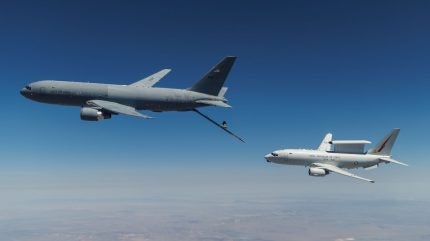
The US, UK, and Australia have successfully completed a joint test of a US Air Force (USAF) KC-46A Pegasus refuelling a Royal Australian Air Force (RAAF) E-7A Wedgetail aircraft.
The tri-nation effort was aimed at enhancing global combat capabilities and collecting vital test data to inform future procurement of the E-7A Wedgetail airborne early warning and control (AEW&C) aircraft.
This collaborative achievement ensures that the KC-46A Pegasus can refuel the RAAF’s E-7A Wedgetail in flight, advancing certification processes for both the USAF and Royal Air Force’s (RAF) E-7 Wedgetail programmes.
This initiative is part of a larger strategy for trilateral cooperation that seeks to improve operational effectiveness through shared support, resources, and system commonality. The goal is to attain higher levels of operational dependability by leveraging efficiencies gained from scale.
The tests were conducted by the 418th Flight Test Squadron, Global Reach Combined Test Force.
During these exercises, a RAAF E-7A Wedgetail was paired with a KC-46A Pegasus tanker in what was the first instance of aerial refuelling receiver certification involving a foreign aircraft type.

US Tariffs are shifting - will you react or anticipate?
Don’t let policy changes catch you off guard. Stay proactive with real-time data and expert analysis.
By GlobalDataWith this capability, the RAAF E-7A can now be refuelled by USAF KC-46 aircraft, extending Australia’s combat range by offering alternatives to the conventional KC-135 Stratotanker and RAAF’s own KC-30A multi-role tanker transport.
The immediate impact of this enhanced combat capability will be felt within the Pacific region, said 412th Test Wing Public Affairs.
Moreover, the collaborative framework established during these tests promises to yield long-term benefits as both the USAF and RAF move towards integrating their respective E-7 Wedgetails in the near future.
Coordinating a tri-national test effort posed its own set of challenges, particularly in navigating the intricacies of secure data exchange between the KC-46 and E-7A platforms, which had not previously interacted.
The mission partner, Boeing, along with the KC-46 programme office, played a crucial role in assisting the 418th Flight Test Squadron to overcome these hurdles, noted the USAF.
An RAF representative took part in the testing process as well, given that the RAF is poised to operate its version of the E-7 Wedgetail. This direct involvement offered invaluable early insights ahead of their anticipated flight test programme.
Conducted over the Mojave Desert, this comprehensive testing heralds a new chapter for networked airborne early warning and control systems. Insights gained from these exercises are already shaping future test plans as both the RAF and USAF gear up for their transition to E-7 Wedgetail operations.
Additionally, this experience has provided the KC-46 with a foundational dataset for certifying unique foreign aircraft types, showcasing a model of efficiency in testing processes, the USAF said.
Last month, Boeing Defence Australia secured a A$569m contract to enhance and maintain the RAAF’s E-7A Wedgetail surveillance aircraft.



